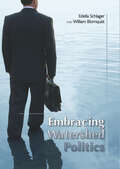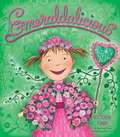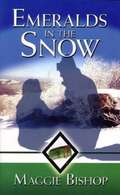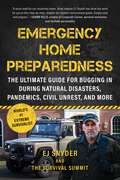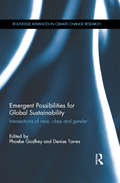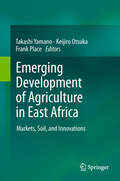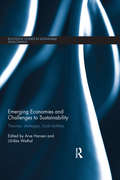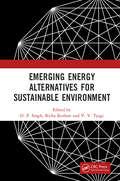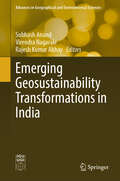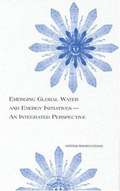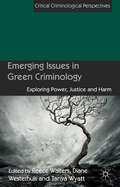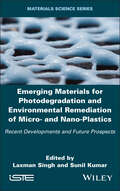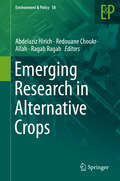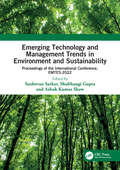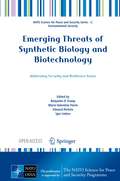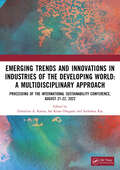- Table View
- List View
Embrace Fearlessly the Burning World: Essays
by Barry LopezAn urgent, deeply moving final work of nonfiction from the National Book Award–winning author of Arctic Dreams and Horizon, a literary icon whose writing, fieldwork, and mentorship inspired generations of writers and activists. ONE OF THE MOST ANTICIPATED BOOKS OF 2022—Lit Hub, BookPageAn ardent steward of the land, fearless traveler, and unrivaled observer of nature and culture, Barry Lopez died after a long illness on Christmas Day 2020. The previous summer, a wildfire had consumed much of what was dear to him in his home place and the community around it—a tragic reminder of the climate change of which he&’d long warned.At once a cri de coeur and a memoir of both pain and wonder, this remarkable collection of essays adds indelibly to Lopez&’s legacy, and includes previously unpublished works, some written in the months before his death. They unspool memories both personal and political, among them tender, sometimes painful stories of his childhood in New York City and California, reports from expeditions to study animals and sea life, recollections of travels to Antarctica and other extraordinary places on earth, and meditations on finding oneself amid vast, dramatic landscapes. He reflects on those who taught him, including Indigenous elders and scientific mentors who sharpened his eye for the natural world. We witness poignant returns from his travels to the sanctuary of his Oregon backyard, adjacent to the McKenzie River. And in prose of searing candor, he reckons with the cycle of life, including his own, and—as he has done throughout his career—with the dangers the earth and its people are facing.With an introduction by Rebecca Solnit that speaks to Lopez&’s keen attention to the world, including its spiritual dimensions, Embrace Fearlessly the Burning World opens our minds and souls to the importance of being wholly present for the beauty and complexity of life.
Embrace Your Inner Wild
by Don Moseman Mary Reynolds ThompsonEmbrace Your Inner Wild: 52 Reflections for an Eco-Centric World is a brilliant, full-color book of photographs and reflections that invite you to seek out wildness wherever you find it - within or without.Don Moseman's spectacular photographs feature the wildlife and terrain of Marin County, California: the fiercely intelligent eyes of the coyote, the spiraling hawk in the supine sky, a bobcat prowling through golden grasses. These photos are paired with reflections by Mary Reynolds Thompson to awaken the reader to wonder. And to oneness.Don spent twenty-five years in San Quentin maximum-security prison in Marin County, California. In 1989, got sober and went straight, encouraged by nature as a guide. Later, taking up photography, the patience he learned in prison paid off. Don knows how to wait for the wild to come to him. Since 1983, the natural world has been key to Mary's successful recovery from alcoholism. A life coach and facilitator of poetry therapy, Mary has developed a unique program of ecological spirituality that connects clients to their true selves through nature.Embrace Your Inner Wild is a visual and verbal psalm to wildness, rooted in Don and Mary's shared love of the earth, its inhabitants, and the wild soul that longs to be set free.
Embrace Your Inner Wild
by Don Moseman Mary Reynolds ThompsonEmbrace Your Inner Wild: 52 Reflections for an Eco-Centric World is a brilliant, full-color book of photographs and reflections that invite you to seek out wildness wherever you find it - within or without.Don Moseman's spectacular photographs feature the wildlife and terrain of Marin County, California: the fiercely intelligent eyes of the coyote, the spiraling hawk in the supine sky, a bobcat prowling through golden grasses. These photos are paired with reflections by Mary Reynolds Thompson to awaken the reader to wonder. And to oneness.Don spent twenty-five years in San Quentin maximum-security prison in Marin County, California. In 1989, got sober and went straight, encouraged by nature as a guide. Later, taking up photography, the patience he learned in prison paid off. Don knows how to wait for the wild to come to him. Since 1983, the natural world has been key to Mary's successful recovery from alcoholism. A life coach and facilitator of poetry therapy, Mary has developed a unique program of ecological spirituality that connects clients to their true selves through nature.Embrace Your Inner Wild is a visual and verbal psalm to wildness, rooted in Don and Mary's shared love of the earth, its inhabitants, and the wild soul that longs to be set free.
Embracing Watershed Politics
by Edella SchlagerAs Americans try to better manage and protect the natural resources of our watersheds, is politics getting in the way? Why does watershed management end up being so political? In Embracing Watershed Politics, political scientists Edella Schlager and William Blomquist provide timely illustrations and thought-provoking explanations of why political considerations are essential, unavoidable, and in some ways even desirable elements of decision making about water and watersheds. With decades of combined study of water management in the United States, they focus on the many contending interests and communities found in America's watersheds, the fundamental dimensions of decision making, and the impacts of science, complexity, and uncertainty on watershed management. Enriched by case studies of the organizations and decision making processes in several major U.S. watersheds (the Delaware River Basin, San Gabriel River, Platte River, and the Columbia River Basin), Embracing Watershed Politics presents a reasoned explanation of why there are so few watershed-scale integrated management agencies and how the more diverse multi-organizational arrangements found in the vast majorities of watersheds work. Although the presence of multiple organizations representing a multitude of communities of interest complicates watershed management, these institutional arrangements can-under certain conditions-suit the complexity and uncertainty associated with watershed management in the twenty-first century.
Embroidered Animal Portraits: A Guide to Thread Painting Fur, Feathers, Spines & Scales
by Michelle StaubCreate stunningly realistic embroidered animal masterpieces Our beloved pets hold a special place in our hearts; we want to capture them in stitches whether they’re covered in fur, scales, or feathers! Join embroidery artist Michelle Staub to immortalize your pets with thread painting. From an adorable rabbit and guinea pig, to a colorful parakeet and stately lizard, you’ll stitch through 12 animal projects that teach you to create a much wider variety of pet portraits. With all the information you need to get started, including supplies, basic stitches, stitch patterns, and color guides, Embroidered Animal Portraits is your handbook for creating strikingly realistic and personalized embroidered masterpieces. Expanding on her first bestselling book, Pet Portrait Embroidery, Michelle Staub offers instruction on stitching a new variety of textures with non-traditional pets, including a hen, hedgehog, snake, and horse! From start to finish, learn to turn an animal photo into a realistic thread painting that captures lighting, detail, and personality. Includes embroidery basics, patterns, and 12 step-by-step animal projects, ranging in skill level from beginner accessible, to intermediate stitcher.
Emeraldalicious
by Victoria KannEveryone's favorite pink-loving gal returns in Emeraldalicious, the imaginative, glitterlicious sequel to the #1 New York Times bestselling Pinkalicious! Pinkalicious combines magic, love, and imagination to turn an ordinary place into an Emeraldalicious world. Pinkalicious and Peter visit their favorite park, but on the way Pinkalicious's wand breaks. She isn't worried at all, because she knows just what to do. She takes a stick, some vines, and a very special flower to make a magical wand. When Pinkalicious and Peter finally arrive at the park it's covered in stinky trash! But never fear, Pinkalicious is here with her magical wand, lots of love, and pinktastic rhymes to turn the trash into an Emeraldalicious paradise.
Emeralds in the Snow
by Maggie BishopEmerald Graham and Lucky Tucker are an unlikely pair. She, accustomed to a life of privilege in which everything's a bit of a game, including her teaching career. He, who has not let his life of struggle keep him from giving to his family, his community and the skiers he rescues on Sugar Mountain. Yet they seem to be finding an uneasy bliss when a treasure hunt and an old murder mystery threaten all they value.
Emergencia bajo la barrera de hielo (¡Arriba la Lectura!, Level M #16)
by Debbie Croft Christine LuitenNIMAC-sourced textbook
Emergency Deep
by Michael DimercurioIslamic terrorists acquire the deadliest submarine in the world
Emergency Home Preparedness: The Ultimate Guide for Bugging In During Natural Disasters, Pandemics, Civil Unrest, and More
by EJ SnyderAre you prepared for the uncertainties that may lie ahead? In a world filled with pandemics, natural disasters, civil unrest, and the constant specter of war, the need for readiness has never been more crucial. Enter EJ Snyder--an extreme survivalist and 25-year Army combat veteran, who has not only faced the challenges of the wilderness on television's "Naked and Afraid," "Dual Survival," and "First Man Out," but has also developed a profound expertise in preparing for emergencies on home turf. In Emergency Home Preparedness, Snyder shares critical insights and life-saving tips gleaned from his extensive military service and survivalist experiences. This comprehensive guide provides a blueprint for individuals from all walks of life. What's Inside: Learn how to prepare a get-home bag and set up your vehicle for emergencies. Understand the framework for "Bugging In" and discover the essentials of P.A.C.E. Planning. Explore considerations for Everyday Carry (EDC), emergency communications, and vehicle preparedness. Gain insights into setting up caches, building community and networking for collective preparedness. Through engaging storytelling, practical advice, and step-by-step instructions, Snyder empowers readers with the tools necessary to thrive amidst uncertainty so they can unlock their potential, embrace the adventurer within, and embark on an awe-inspiring journey of knowledge and self-discovery. Emergency Home Preparedness is the essential guide to uncovering the secrets of survival, resilience, and the indomitable human spirit in the face of any challenge.
Emergent Possibilities for Global Sustainability: Intersections of race, class and gender (Routledge Advances in Climate Change Research)
by Phoebe Godfrey Denise TorresIt must be acknowledged that any solutions to anthropogenic Global Climate Change (GCC) are interdependent and ultimately inseparable from both its causes and consequences. As a result, limited analyses must be abandoned in favour of intersectional theories and practices. Emergent Possibilities for Global Sustainability is an interdisciplinary collection which addresses global climate change and sustainability by engaging with the issues of race, gender, and class through an intersectional lens. The book challenges readers to foster new theoretical and practical linkages and to think beyond the traditional, and oftentimes reductionist, environmental science frame by examining issues within their turbulent political, cultural and personal landscapes. Through a variety of media and writing styles, this collection is unique in its presentation of a complex and integrated analysis of global climate change and its implications. Its companion book, Systemic Crises of Global Climate Change, addresses the social and ecological urgency surrounding climate change and the need to use intersectionality in both theory and practice. This book is a valuable resource for academics, researchers and both undergraduate and post-graduate students in the areas of Environmental Studies, Climate Change, Gender Studies and International studies as well as those seeking a more intersectional analysis of GCC.
Emerging Development of Agriculture in East Africa
by Frank Place Keijiro Otsuka Takashi YamanoEmerging Development of Agriculture in East Africa offers case studies that find promise in many new innovations. Farmers in Uganda have quickly learned the management of NERICA rice (a new upland rice variety), which is being disseminated in a limited way in the region. Also in Uganda, farmers living in more remote areas have improved access to markets due to the expansion of mobile phones. In Kenya, improved milk marketing systems have increased efficiency and led to tangible increases in the adoption of dairy production technologies. And the adoption of intensive dairy production systems in Kenya and Uganda are providing significant amounts of manure and positively impacting yields of maize and banana.
Emerging Digital Media Ecologies: The Concept of Medialogy
by Toija CinqueEmerging Digital Media Ecologies: The Concept of Medialogy investigates the profound ways in which digital media reshapes our cultural, socio-technological, political, and natural landscapes. Through interdisciplinary empirical and creative case studies, the book defines and illuminates the nuances of medialogy, emphasising the often-underestimated impact of emerging technologies across interactive education, data gathering, visual-data representations, and creative practice. It explores the intersection of the natural and technological worlds, contextualising our use of natural resources against climate change and sustainable economies.Divided into two parts, the book delves into the theoretical underpinnings of digital media ecologies and their practical applications. Part 1 traces the evolution of media technologies, examining their environmental impact and the foundational approaches to understanding media’s complex interconnections. Part 2 focuses on contemporary issues such as hyperpersonalised media, digital literacy, and the transformative power of Indigenous media narratives.Additionally, the monograph explores the revolutionary role of Artificial Intelligence (AI) and large language models like ChatGPT-4o and those that follow in shaping our digital future. It investigates how AI transforms creative practices, data processing, and communication, contributing to the formation of new media ecologies. The ethical implications, commodification, identity formation, and the impact of AI-driven technologies on everyday life are critically examined, offering insights into the future of human–technology interactions.This book is a crucial reference for scholars, practitioners, and students in digital humanities, media studies, environmental humanities, and anyone interested in the cultural implications of emerging digital technologies and their impact on our environment and society.
Emerging Economic Models for Sustainable Businesses: A Practical Approach (Responsible Leadership and Sustainable Management)
by René Schmidpeter Nayan Mitra Jayati TalapatraThe book discusses new and emerging economic models, that respond to 'Pulling' and 'Pushing' forces. Today we are poised at an interesting juncture, with favourable conditions making it easier to be a sustainable organization acting as a ‘Pulling’ Force and the climate crisis, rise in social-economic equities thereby ‘Pushing’ for urgent action. The book analyses economic models that look at value propositions, creation and capture with ‘People, Planet and Profit’ deeply embedded in each stage of the value chain. The contributions bring out the interplay between new standards, evaluation frameworks, technology innovation and other emerging tools to show how they create a sustainable business. For this, they lean on learnings from successful sustainable businesses. Business leaders will find that this book provides deep insights on improving their existing sustainable practices, and speeding up the transition from linear to circular, narrow stakeholder driven to community driven. For prospective entrepreneurs the book provides the nudge needed to start up a sustainable enterprise. Students and researchers can benefit from real-life examples of how sustainable transformations unfold.The book thus creates an easy guide for those willing to make the transition to sustainability, start a sustainable business and most of all, to motivate those who may not yet be convinced about the long-term sense of taking care of our people and our earth.
Emerging Economies and Challenges to Sustainability: Theories, strategies, local realities (Routledge Studies in Sustainable Development)
by Arve Hansen Ulrikke WethalThe rise of emerging economies represents a challenge to traditional global power balances and raises the question of how we can combine sustainability with continued economic growth. Understanding this global shift and its impact on the environment is the paramount contemporary challenge for development-oriented researchers and policy makers alike. This book breaks new ground by combining scholarship on the role of emerging economies with research on sustainable development. The book investigates how the development strategies of emerging economies challenge traditional development theory and sustainability discourses. With regional introductions and original case studies from South Asia, East Asia, Latin America and Sub-Saharan Africa, it discusses how to conceptualise sustainable development in the global race for economic prosperity. What characterises the development strategies of emerging economies, and what challenges are these posing for global sustainable development? How can emerging economies shed light on the global challenges, dilemmas and paradoxes of the relationship between socio-economic improvements and environmental degradation? This book will be a valuable resource for researchers and postgraduates in development studies, geography, economics and environmental studies.
Emerging Energy Alternatives for Sustainable Environment
by Richa Kothari D. P. Singh V. V. TyagiSustainability of environment is an emerging global issue at present. Unsustainable or deteriorating environment is a matter of concern as it has threatened the survival of living creatures. Recently, climate change has been a matter of great concern at a global platform owing to imbalances in natural environment. Increasing population has increased the demand for energy, which has ultimately put pressure on natural resources and caused a paradigm shift from resource generation to exploitation. Emerging Energy Alternatives for Sustainable Environment aims to address the role of sustainable technologies in energy generation options for clean environment. It covers a wide spectrum of energy generation approaches, with an emphasis on five key topics: (i) renewable energy sources and recent advances, (ii) emerging green technologies for sustainable development, (iii) assessment of biomass for sustainable bioenergy production, (iv) solid waste management and its potential for energy generation, and (v) solar energy applications, storage system, and heat transfer. This book provides essential and comprehensive knowledge of green energy technologies with different aspects for engineers, technocrats and researchers working in the industry, universities, and research institutions. The book is also very useful for undergraduate and graduate students of science and engineering who are keen to know about the development of renewable energy products and their corresponding processes. Please note: This volume is Co-published with The Energy and Resources Institute Press, New Delhi. Taylor & Francis does not sell or distribute the Hardback in India, Pakistan, Nepal, Bhutan, Bangladesh and Sri Lanka
Emerging Geosustainability Transformations in India (Advances in Geographical and Environmental Sciences)
by Subhash Anand Virendra Nagarale Rajesh Kumar AbhayThis book presents the emerging sustainability concerns for India to achieve holistic development. India is densely populated with scattered natural resources and is engaged in developing technology and its infrastructure. However, India’s sustainability is questioned from the viewpoints of environment, society, economy and politics. As the Sustainable Development Goals (SDGs) aims to achieve a sustainable world by 2030, India has to relook at its current development approaches and make effective policy measures. Geography is an interdisciplinary branch of social science that focuses on the interrelationships among population, natural resources, social linkages, governments and public policy. Within this interdisciplinary concept, the book presents a collection of studies from scholars in India. We ask questions such as, (1) what major geographical approaches and perspectives exist related to sustainability, (2) how socioeconomic and political factors affects sustainability and SDGs, (3) what approach is the most effective from the sustainability perspective, and (4) how we address sustainability issues. The book serves as a valuable reference for those who are concerned with the progress of sustainability in India.
Emerging Global Water and Energy Initiatives-- An Integrated Perspective
by Global Energy Water Cycle Experiment Gewex PanelThe National Academies Press (NAP)--publisher for the National Academies--publishes more than 200 books a year offering the most authoritative views, definitive information, and groundbreaking recommendations on a wide range of topics in science, engineering, and health. Our books are unique in that they are authored by the nation's leading experts in every scientific field.
Emerging Issues in Green Criminology
by Tanya Wyatt Reece Walters Diane Solomon WesterhuisThis edited collection brings together internationally renowned scholars to explore green criminology through the interdisciplinary lenses of power, harm and justice. The chapters provide innovative case study analyses from around the world that seek to advance theoretical, policy and practice discourses about environmental harm.
Emerging Materials for Photodegradation and Environmental Remediation of Micro- and Nano-Plastics: Recent Developments and Future Prospects (ISTE Invoiced)
by Sunil Kumar Laxman SinghEmerging Materials for Photodegradation and Environmental Remediation of Micro- and Nano-Plastics provides an in-depth understanding of the materials, design choices and applications needed for the mitigation of micro- and nano-plastic pollutants from environmental wastewater. This is a topic that continually attracts attention worldwide. This is an important book for academic institutes and libraries, scientific organizations, and global research industries, and has been created for a wide audience. The book provides the scope of material design, synthesis, detailed mechanisms, spectroscopic analysis, and problem-solving strategies in environmental remediation. The scope of the book on reactive, functional materials and applications extends far beyond the emerging technologies that possess valuable insights of the synthesis, processing and physiochemical characteristics and their functional properties for academics, postgraduates, research scholars, scientists, technologists, environmental chemists and industrialists. This book presents fifteen chapters, which explore new ideas in processing, designing, synthesis, selection, application, photocatalytic efficiency and economic justifications of emerging materials.
Emerging Research in Alternative Crops (Environment & Policy #58)
by Ragab Ragab Redouane Choukr-Allah Abdelaziz HirichThis book provides case studies on cultivating alternative crops and presents new cropping systems in many regions of the world. It focusses on new emerging research topics aiming to study all aspects of adaptation under several stresses including agricultural, environmental, biological and socioeconomic issues. The book also provides operational and practical solutions for scientists, producers, technology developers and managers to succeed the cultivation of new alternative crops and, consequently, to achieve food security.Many regions in the world are suffering from water scarcity, soil and water salinization and climate change. These conditions make it difficult to achieve food security by cultivating conventional crops. A renaissance of interest for producing alternative crops under water scarcity and water salinization has been, therefore, implemented primarily among small-scale producers, researchers and academics.The use of alternative crops (quinoa, amaranth, legume crops, halophytes, …etc.) may provide some environmental benefits such as valorization of salt-affected soils, reduced pesticide application, enhanced soil and water quality and promotion of wildlife diversity. This also may provide some economic benefits such as providing the opportunity for producers to take advantage of new markets and premium prices, spreading the economic risk and strengthening local economies and communities. Furthermore, alternative crops are often rich in proteins and minerals, and even some of them are Gluten free (quinoa). This reflects their importance to achieve food security in quantity and quality scale. The year 2013 was exceptional for alternative crops as it was the international year of quinoa celebrated by Food and Agriculture Organization (FAO). This reflects the importance of research conducted on quinoa and other alternative crops in many regions of the world.
Emerging Technologies in Agriculture, Livestock, and Climate
by Abid YahyaThis book provides applications of wireless sensor networks (WSN) in environmental monitoring, with an emphasis on livestock disease detection and agricultural management in Africa to aid farmers. This proposed system entails current and innovative monitoring technologies intended to improve agricultural conditions in Africa, with a focus on Botswana, and addresses the Internet of Things (IoT) as a set of remote monitoring protocols using WSNs to improve and ensure proper environmental maintenance. In this book, the author introduces WSNs, and how the IoT can be applied to develop a system of "smart agriculture" in Africa, taking into account livestock health, climate change impacts on crops and wildlife, and technological innovations in response to climate change such as windmills and solar panels. The book will be interesting to students and researchers in engineering and life sciences, as well as practitioners working with sensing technologies for agricultural monitoring and improvement.
Emerging Technology and Management Trends in Environment and Sustainability: Proceedings of the International Conference, EMTES-2022
by Sushovan Sarkar Shubhangi Gupta Ashok Kumar ShawThe International Conference (EMTES 2022) is oriented to include the themes like Water Quality Management, Advanced Water Treatment, Advanced Wastewater Treatment, Assessment and Control of Air Pollution, Solid and Hazardous Waste Management, Prevention of Groundwater Contamination, Wetland Management/Phyto-remediation, Case studies in Industrial Pollution Control, Liquid waste management, recent advancement in engineering, technology and management for optimization of environmental issues, application of IOT and IT in remedial measure of Environment and sustainability, Health issues and safety.
Emerging Threats of Synthetic Biology and Biotechnology: Addressing Security and Resilience Issues (NATO Science for Peace and Security Series C: Environmental Security)
by Igor Linkov Benjamin D. Trump Marie-Valentine Florin Edward PerkinsSynthetic biology is a field of biotechnology that is rapidly growing in various applications, such as in medicine, environmental sustainability, and energy production. However these technologies also have unforeseen risks and applications to humans and the environment. This open access book presents discussions on risks and mitigation strategies for these technologies including biosecurity, or the potential of synthetic biology technologies and processes to be deliberately misused for nefarious purposes. The book presents strategies to prevent, mitigate, and recover from ‘dual-use concern’ biosecurity challenges that may be raised by individuals, rogue states, or non-state actors. Several key topics are explored including opportunities to develop more coherent and scalable approaches to govern biosecurity from a laboratory perspective up to the international scale and strategies to prevent potential health and environmental hazards posed by deliberate misuse of synthetic biology without stifling innovation. The book brings together the expertise of top scholars in synthetic biology and biotechnology risk assessment, management, and communication to discuss potential biosecurity governing strategies and offer perspectives for collaboration in oversight and future regulatory guidance.
Emerging Trends and Innovations in Industries of the Developing World: A Multidisciplinary Approach
by Sai Kiran Oruganti Sudeshna Ray Dimitrios A. KarrasISC 2022 is dedicated to the Niti Aayog policies to promote sustainability through exchange of ideas emerging out of the academia. The ISC is an annual conference that is held in virtual mode until COVID restrictions on travel exist. The vision of the conference is to capacitate Academia with the necessary ideas that provide insights of the grassroot level development to various stakeholders of the Niti-Aayog policies. Towards this goal, the conference creates a conjunction of various stakeholders of Niti-Aayog policies that include- academic institutions, government bodies, policy makers and industry. The ISC organizers make concerted efforts to promote academic research that would technological, scientific, management & business practices, and insights into policy merits & disruptions. The framework of exchange of ideas is geared towards adoption of deep technologies, fundamental sciences & engineering, energy research, energy policies, advances in medicine & related case studies. This framework enables the round table discussions between the academia, industry and policy makers through its range of plenary and keynote speakers.


